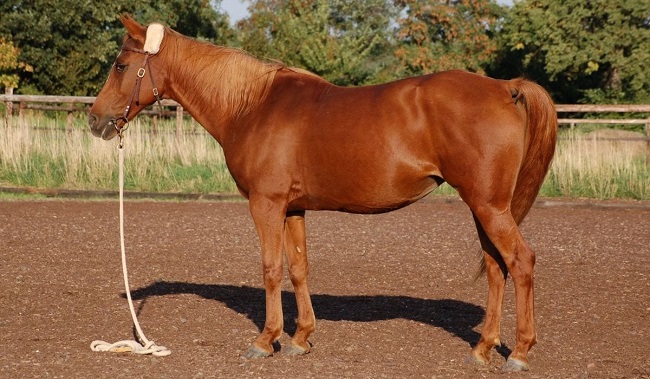
Ground-tying teaches horses to have more respect of the human and patience. Your horse learns an enhanced respect for you, no matter where you are and at what distance you are from them. A horse that has refined this skill gives the appearance of being tied on an invisible lead rope. This is a result of their respect and focus on you and they understand that you are always in control. At a more advanced level it creates a patient demeanor because your horse learns to wait for you.
I do believe that ground tying does hold great benefits and comes in very handy when you won’t be able to tie your horse to something or find a person who can hold them for you. It’s also handy for when you may have to retrieve an item that you left somewhere or that is in a location that is not conducive for you to have the horse tag along while you pick it up. Simple tasks such as grooming, and saddling are also easier if the horse ground ties or if you must dismount to remove an obstruction while on the trail. As with many things horse people encounter, they stay away from becoming involved in teaching it. But the task of training a horse to ground tie is quite a simple process.
Start ground tying lessons after you have come back after a long tiring ride. By doing it then, the horse associates ground tying with a rest period. Some would argue that the horse is just staying in place because they are tired, and you aren’t training them to have any association with it. Fact is, you have provided comfort, relaxation, and relief from physical work by dropping and not tying the reins/lead line to a fixed object. If a horse is not very experienced in all forms of training, you can’t expect great results because they don’t fully understand what you are asking of them.
To begin this lesson. After riding and dismounting the horse, give them the verbal command to ‘whoa’ and immediately move to their front end and pick up the reins or lead rope. Get the horse to focus on you and say ‘stand’ or ‘whoa’ and raise your free hand to give a visual signal like a traffic officer signaling you to stop your vehicle. Then drop the reins and walk away. Your horse may want to follow you. If they do, don’t get frustrated. Go to their side and have them back up a step or two back to where they had been placed initially. Rub your horses’ neck rhythmically to give them reassurance and repeat the process. Walk away slowly even a step or two and go back to the horse and assure them with the rhythmic rub that by staying still they have made the right choice. Keep repeating the process by adding a few extra steps going away from the horse and return to the horse if correction is necessary.
When a considerable distance between you and the horse can be reached, you may want to add a long rope to provide yourself with a safety net, particularly if you are teaching this in an area that is not fenced in. Once the horse seems to have mastered the concept in a confined area you can then attempt it in a larger area. Ensure that each time in the learning process you are teaching this that you have your horses’ attention. When they have developed a level of relaxation and understanding of the task, then perform the same process where there are minimal distractions. Avoid what the horse perceives to be reprimands. Try not to have quick abrupt reactions like running toward them and grabbing the reins or lead rope to administer a physical correction. That will teach the horse that you are being disrespectful to them. We want to build the trust bond and the relationship not detract from it. In short order you will find that your horse is on the way to perfecting a new learned skill.
Who knows how much you will use ground tying, but before long, you will find it much easier than having to constantly seek out places to tie them. Keep in mind that the ground tie is only as strong as the relationship. When in doubt as to whether the horse will ground tie for an extended period use your rope as a safety net to guarantee the horse does not get spooked and leave the area before you can safely catch them. To obtain success in training, I suggest that you begin teaching this and all new tasks in small steps. Increase only when your horse begins to comprehend and become compliant with your requests. Attempting to do too much, too quickly will not achieve the desired results. Also, begin by doing it in an area where your horse will concentrate on you rather than other issues going on in their environment that may cause distraction. It also provides you with a controlled space for them to retreat while they learn and comply with your request. As with all education and training of the horse, set them up for success not for failure, you will both be happier as a result.
Provided by Dan Kuhn Natural Horse-Man Services
Related Articles & Free Email Newsletter Sign Up
DIY Nutritional Supplements & Health Care for Horses
How & When to Halter Train a Foal
How to Deal with a Horse That has Rolled into a Cast Position




Comment here